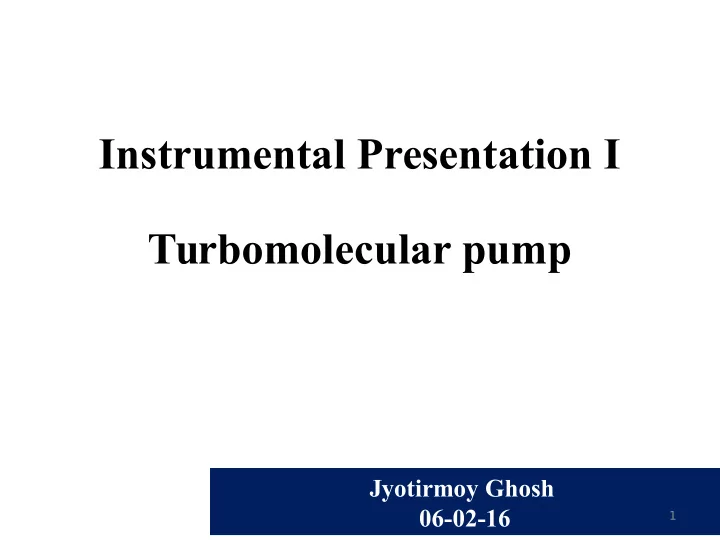

Instrumental Presentation I Turbomolecular pump Jyotirmoy Ghosh 06-02-16 1
Why is vacuum needed? (High)Vacuum Atmosphere Contamination Clean surface (usually water) To provide a clean surface
Pressure Ranges Vacuum Pressure (mbar) Low Vacuum >1013-10 -3 (mbar) High Vacuum 10 -3 -10 -8 (mbar) Ultra High Vacuum 10 -8 -10 -12 (mbar) Extreme High Vacuum 10 -12 -10 -14 (mbar)
Introduction A Vacuum pump is a device that removes gas molecules from a sealed volume in order to leave behind a partial empty space. The first vacuum pump was invented in 1650 by Otto von Guericke , and was preceded by the suction pump, which dates to antiquity. Basically, there are three different types of vacuum pumps, which are explained in details as below:- Positive Displacement Vacuum Pumps Momentum Transfer Vacuum Pumps Entrapment Pumps 4
Difgerent types of pumps VACUUM PUMPS Gas Transfer Entrapment Vacuum Pump Vacuum Pump Positive Displacement Kinetic Adsorption Vacuum Pump Pump Vacuum Pump Reciprocating Rotary Drag Fluid Entrainment Ion Transfer Cold Trap Pump Displacement Pump Pump Pump Pump Ejector Gaseous Bulk Getter Getter Diaphragm Liquid Ring Pump Pump Pump Pump Pump Ring Pump Piston Rotary Turbine Liquid Jet Diffusion Getter Ion Sublimation Pump Piston Pump Pump Pump Pump Pump Pump Multiple Vane Sliding Vane Axial Flow Gas Jet Diffusion Self Purifying Evaporation Pump Pump Ejector Pump Diffusion Pump Ion Pump Rotary Pump Rotary Pump Radial Flow Vapor Jet Fractionating Sputter Ion Rotary Pump Diffusion Pump Plunger Pump Pump Pump Dry Roots Molecular Cryopump Pump Pump Drag Pump Turbomolecular Condenser Pump 5
T urbomolecular pump (TMP) TMP is a momentum transfer pump it works on the principle that gas molecules can be given momentum in a desired direction by repeated collision with a moving solid surface. In a TMP, a rapidly spinning fan rotor or blade 'hits' gas molecules from the inlet of the pump towards the exhaust in order to create or maintain a vacuum. The blade surface is rough, so no reflection will occur and it is thick and stable for high pressure operation. The blade surface looks down, most of the scattered molecules will leave it downwards and for high flow rates the blades are at 45° and close to the axis. TMP cannot work if it is exhausted directly to atm pressure, less than 10 -2 mbar exhaust pressure is required for its function. Till now there is no TMP which can work directly to atm. • Pressure Range: 10 -6 to 10 -12 mbar (UHV Region) 6
History and development of T urbomolecular pump The turbomolecular pump was invented in 1958 by Becker , based on the older molecular drag pumps developed by Gaede in 1913 , Holweck in 1923 and Siegbahn in 1944 . Considerable development has taken place since 1958 when the first pumps were made. Early pumps were dependent on oil or grease lubricated bearings, but the demand for flexibility and greater cleanliness, we saw the development and introduction of ceramic ball-bearings. These bearings are lubricated for life and have lower mass, giving lower radial forces which reduces running temperature and increases bearing life . Magnetic bearings using high-field permanent magnets have also been developed. To improve further the cleanliness of a system, the conventional oil-sealed rotary vane backing pump is replaced with a ‘dry pump’ or ‘Diaphragm pump’. 7
T urbomolecular pump (TMP) INLET FLANGE ROTOR BLADES STATOR BLADES HIGH PUMPING SPEED HIGH COMPRESSION BEARING EXHAUST HIGH FREQ. MOTOR BEARING
Turbomolecular Pump
T urbomolecular pump (TMP) Rotor - stator assembly 10
Pumping speed of T urbomolecular pump Volumetric flow rate, S=A.v A=Area, v=velocity Throughput, Q=P.S P=Pressure Conductance, C=Q/(P 2 -P 1 ) Conductance should be very large for high vacuum, ideally it should be infinite. The pumping speed of a TMP depends on 4 basic parameters: 1. The diameter of the rotor and the blade height, which determines the entrance area. 2. The peripheral rotational velocity. 3. The blade angle of the rotor. 4. The blade spacing ratio. [i.e., the distance between blades divided by the width] 11
Compression ratio Compression ratio for different gases, Compression ratio=Outlet pressure/Inlet pressure 12
General operating instructions In spite of the relatively large gap between the pump rotor and the stator, the pumps should be protected against foreign objects entering through the intake port. It is for this reason that the pump should never be operated without the supplied wire-mesh splinter guard. In a radioactive environment standard TMP can be used without hazard at dose rates of from 10 4 to 10 5 rad. Since the semiconductors used inside the electronic frequency converters can tolerate a dose rate of only about 10 5 rad. Roughing (backing) pumps are required for the operation of TMP. Depending on the size of the chamber to be evacuated, the TMP and backing pumps may be switched on simultaneously. Thank you 13
Recommend
More recommend